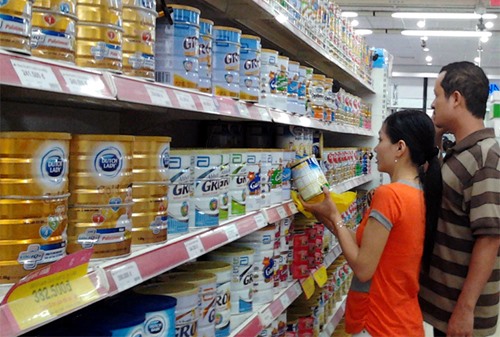 Talk Around Town
Talk Around Town
.jpg)
Ceiling prices on dairy products for children under six will be removed on April 1. With just three days left until that date, enterprises making and selling the formula products are happy, but mothers with under-six children are anxious.
 |
Kiều Vân
If nothing changes, ceiling prices on dairy products for children under six will be removed on April, 1.
With just three days left until that date, enterprises making and selling the formula products are happy, but mothers with under-six children are anxious. They don’t know whether this decision will be good or bad for them, in terms of pricing and availability.
Nguyễn Bích Hà has two children under six. She feels that if no State management agency is responsible for controlling the price of domestic dairy products, their prices can spiral out of control. She understands that the rationale is that with no price ceilings or other constraints, producers and distributors will adjust prices according to market supply and demand.
However, this would mean that “we consumers will completely depend on the business strategy of milk producers,” said a clearly worried Hà.
Makes no difference
Another mother in Hà Nội, Nguyễn Thu Vân, noted that despite the price ceilings put in place in May 2014 by the Ministry of Finance, the prices of imported milk products were higher than other countries in the region.
“In the past few years, despite all the price controls, the retail price of both locally produced and imported milk have been high. Việt Nam’s milk price is also "top" compared to other countries in Southeast Asia, so consumers are always losing out,” Vân said.
During two years of price ceilings for milk products, enterprises have rarely reduced prices, and most customers waited for trade promotions to make their purchases, she said.
“So let the market decide the price.”
Vân said she paid more attention to the quality of milk products rather than price. In the context of food poisoning happening in both developing and developed countries, “I want to know exactly what products I buy have passed inspections by qualified State agencies.”
The other side
Many domestic milk producers have complained that both sales and profit have reduced when ceiling prices were applied.
They say it is unreasonable to apply price ceilings anymore. If they are persisted with, it will be difficult for local companies to invest in new products, and this will put consumers at a disadvantage because there are not many products to choose from, said a representative from one of a biggest domestic dairy companies who wanted to remain anonymous.
He said the ceilings also imposed unfair competition between domestic and foreign milk producers. While some domestic milk products had to cut prices by 15 per cent, that of foreign products only fell by one per cent, he said..
Meanwhile, Vũ Ngọc Quỳnh, general secretary of the Việt Nam Dairy Association, said that abolishing the ceiling would encourage milk producers to invest more in production lines and increase competition among them.
The argument is that competition will allow a healthier, fairer milk market to develop in the country. Dairy firms would fix prices depending on production and material costs and they would compete to increase their market shares, ultimately benefiting the customer.
But Quỳnh tried to allay concerns saying that even after removing price ceilings, it would be difficult for dairy firms to charge very high prices because they will have to register these with the authorities and obtain permission.
At present, 877 milk products for children under six have been listed and their registered prices posted on the websites of the Finance Ministry and local finance departments across the nation.
Input controls
Several economists have said when the State abolishes the ceiling price, it should control milk prices via input materials instead.
Pricing expert Ngô Trí Long with the Finance Ministry said that to manage input materials effectively, synchronous co-ordination between the tax, customs, finance offices was needed.
So this much is clear. Whether or not ceiling prices are removed, the State will still have the job of protecting the consumer by ensuring pricing transparency and preventing monopolistic control in the domestic market.
How this will happen is not clear yet, but the State should be prepared to step in again in the interests of the end consumer, the mother or the under-six child. – VNS